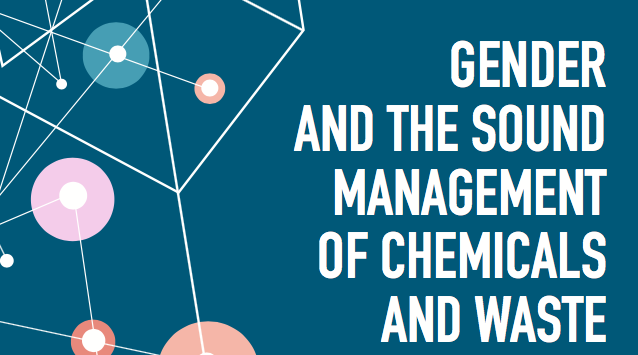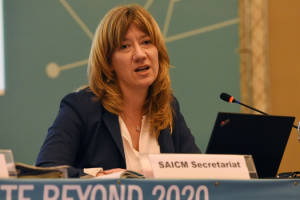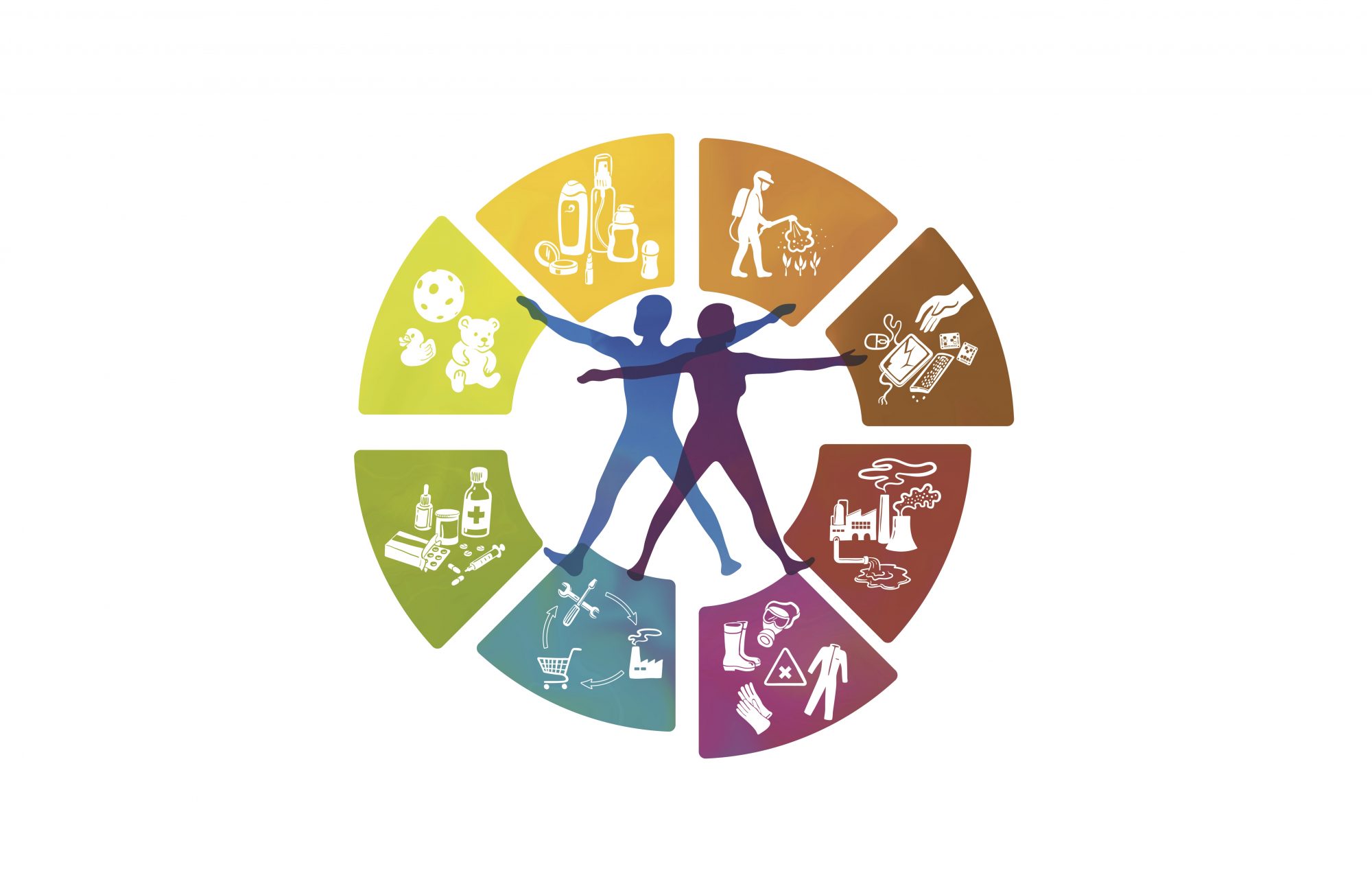#Expert – Blog series: How to create a gender-just healthy planet
by Brenda Koekkoek, SAICM Secretariat

It’s a fact that chemicals are in everything we touch and that chemicals are essential for our sustainable development and future. Yet while chemical exposure can pose a risk to all, it has been shown to affect men and women differently, whether due to physical conditions or in reproductive health.
The susceptibility to chemical exposure varies according to sex – starting in the womb, through childhood and the first years of development to puberty, when adolescents are particularly susceptible. In order to ensure the health of future generations, the different vulnerabilities of men and women must be understood and considered.
The gender dimensions of the sound management of chemicals and waste are highly relevant. Exposure to chemicals depends on geographical location, behavioural patterns, age, nutritional status, and other biological factors. Hence, sex and gender are highly influential in an individual’s physiological susceptibility to chemicals. For example, the varying roles of men and women in the workplace and at home help determine respective exposures and vulnerabilities to chemicals. Because of largely gender segregated labour markets, there are many occupations involving chemicals that affect either women or men to a larger extent.
Although often overlooked, domestic exposures to chemicals and toxins must also be considered. Men and women use different personal care products and cosmetics and are affected differently. For example, women tend to use more personal items than men, and with over 5,000 different ingredients used in the personal care industry, it increases their dermal exposure to chemicals. Work involving household cleaning products also leads to chemical exposures, and with changing gender roles, exposure patterns also change.
With the size of the global chemical industry projected to double by 2030, there is a growing concern for people working in chemically intensive sectors such as agriculture, construction, electronics and textiles. Women are also increasingly working in the informal sector and rarely receive basic training about the chemicals they use, which increases their vulnerability to pesticide-related health risks.
Now more than ever, it is vital that measures are taken to ensure that the needs of particularly vulnerable demographics are met, when it comes to the sound management of chemicals. In considering reproductive health as an example, both parents have susceptibilities that must be understood for the health of future generations.
One step in the right direction is gender mainstreaming. This is defined as a strategy for equally making both men and women’s concerns, needs, and experiences an integral part of policies and programmes in political, economic and societal spheres. The Sustainable Development Goals (SDGs) of the 2030 Agenda aim to address inequalities among all population groups – especially women, children, and the impoverished. Particularly, SDG5 aims to achieve gender equality and improve women’s rights. Directly addressing the links between the environment and gender in the context of the SDGs will provide new opportunities to achieve these goals in a more sustainable and beneficial manner and can yield tangible results and will provide benefits for both women and men.
UN Environment and the International POPs Elimination Network (IPEN) are working in partnership on gender and chemicals, in particular on raising awareness, promoting womens’ engagement and leadership in decision-making processes as well as contributing to activities related to the Strategic Approach emerging policy issues and relevant SDGs. Furthermore, it is very positive that gender considerations have been increasingly incorporated into global multilateral environmental agreements, including the Basel, Rotterdam and Stockholm Conventions and the Minamata Convention on Mercury.
Gender and the SAICM Emerging Policy Issues
SAICM stakeholders have identified eight emerging policy issues and other issues of concern since the inception of the Strategic Approach in 2006. In general, all of these have susceptibility and exposure considerations related to gender, which I would like to illustrate:
1. Lead in paint
Lead, a widely used toxic metal, contaminates the environment and causes extensive public health problems. Children are particularly vulnerable and the exposure of pregnant women to high levels of lead may cause miscarriage, stillbirth, premature birth, and minor malformations.
2. Highly hazardous pesticides
Understanding gender roles in agricultural communities can create opportunities to unpack root causes of unsustainable behaviour in communities and has potential to support transformational change. For example, a large number of women in South Asia, East Asia, and sub-Saharan Africa work in agriculture and related tasks such as washing pesticide containers and thinning crops exposed to pesticides. The resulting exposure calls for the regulation of the use of highly hazardous pesticides.
3. Chemicals in products (CiP)
Efforts to label and classify chemicals help consumers make informed choices. By engaging with consumer product sectors, there are opportunities to empower workers and consumers, for example, to understand potential exposures to chemicals and to target initiatives to empower particular vulnerable groups. UNEP’s Chemicals in Products programme promotes transparency of information in supply chains and is currently focused on, but not limited to, the following sectors: textiles, toys, building materials, and electronics.
4. Hazardous substances within the life cycle of electronic products
The manufacture of electrical and electronic products relies on the use of over 1,000 chemicals, many of which lack comprehensive health and safety information due to weak regulatory policies. As the electronics industry has grown, women in Latin America and Asia have become the primary source of labour, and are now exposed to high levels of toxins such as lead and chromium.
5. Nanotechnology and nanomaterials
Nanomaterials, which can be found in many consumer products, can affect both male and female reproductive systems. These materials are prevalent in pharmaceuticals and textiles, and in the products related to information and communications technology.
6. Endocrine-disrupting chemicals (EDCs)
EDCs affect the hormone systems of men, women and children. The International Federation of Gynecology and Obstetrics notes that the global rise in non-communicable diseases, as well as the increase in preterm births, low-birth-weight babies, and the early onset of breast development can be partially attributed to EDCs.
7. Environmentally persistent pharmaceutical pollutants (EPPPs)
The sources of pharmaceutical pollution include drug manufacturing, human excretion, disposal from homes and hospitals, and wastewater from large-scale livestock operations. However, gender-specific effects of EPPPs remain largely unknown, due to the limited methods to measure such a wide-spread phenomenon.
8. Perfluorinated chemicals (PFCs)
PFCs have become extensively used in both industrial and consumer products to make them resistant to stains, water, grease, or heat. Studies have shown that high levels of PFCs can be highly toxic, and animal tests have found PFCs to be potentially carcinogenic in the reproductive and fetal development stages, although these effects on humans remain inconclusive.
In general, all of the SAICM emerging policy issues and other issues of concern have susceptibility and exposure considerations related to gender, though no on-going gender activities are formally identified within the Strategic Approach context. A gender review across the current emerging policy issues and other issues of concern has been initiated as part of the SAICM GEF Project on global best practices on SAICM emerging policy issues.
What can we do for the future?
There are numerous relevant, diverse and influential stakeholders that can contribute and enable gender mainstreaming in chemicals and waste management. These include, amongst others, national and local governments, intergovernmental organizations, regulatory bodies, regional bodies, donor organizations, NGOs, industry associations, farmer organizations, media, consumers, employers, educators and researchers, health professionals, workers and trade unions and indigenous peoples.
When it comes to designing the future for SAICM and the sound management of chemicals and waste beyond 2020, all stakeholders have the opportunity to tap into the potential to address gender issues, promote equality, and protect vulnerable populations in line with the 2030 Agenda for Sustainable Development.
Strong legislation, effective information systems as well as scientific evidence and knowledge for chemicals are at the core of the SAICM community efforts on emerging policy issues today and remain relevant in the future to protect human health and the environment from harmful effects of chemicals across the lifecycle. There are additional opportunities for strengthening focus on developing, collecting and analysing gender-disaggregated data, indicators and other information to support decision-making.
Let’s work together in moving forward to apply a joint gender lens in our work-planning, prioritizing, implementing and decision-making!
This article is based on the policy brief by the SAICM Secretariat; published September 2018 at http://www.saicm.org/Portals/12/Documents/SDGs/SAICM_Gender_Policy_Brief.pdf.
Please follow SAICM on twitter @chemandwaste
To find out more about SAICM, please visit http://www.saicm.org
Author

Brenda Koekkoek works with the Strategic Approach to International Chemicals Management (SAICM) Secretariat, administered at the United Nations Environment Programme. Brenda has over fifteen years of environmental policy-related experience, particularly in relation to pollution. She is a Canadian national, previously working with Environment and Climate Change Canada. Much of her work has focused on building strategic partnerships as well as overseeing stakeholder consultation processes.
